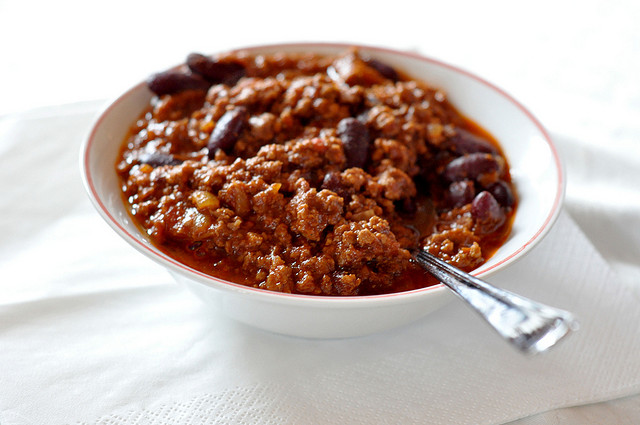Hokkaido Home Cooking: Chili Con Carne
Back in the days when regional cuisines were considered provincial and the word ‘authentic’ had yet to be uttered in a kitchen, there was no such thing as chili in most of the United States. Instead there was a dish called Chili Con Carne, and it was a staple at diners and lunch counters everywhere. The version presented here is adapted from a recipe dating from the 1950s at the latest and originally published by Craig Claiborne, the legendary Food Critic of the New York Times in that golden era.
Chili Con Carne is a perfect choice for a warming meal now that the evenings are getting colder. It’s easy to make, it’s easy to make a lot of (meaning plenty of leftovers for freezing), and everyone likes it, especially Japanese people.
6 TBSP (90 ml) olive oil
2 onions, diced
6 or 7 or 10 cloves of garlic, minced
2 pounds (900 g) beef or other meat, ground or cut into bite-sized pieces
6 cups water or beer (1.4 liters)
28 ounces (800 g) canned tomatoes (diced, not whole)
2 bell peppers, diced
1 TSP (5 g) celery seed
1/2 TSP (2 g) cayenne pepper
2 heaping TSP (+9 g) ground cumin
2 bay leaves
4 TBSP (55 g) chili powder
1 heaping TSP (+5 g) basil
1 heaping TSP (+5 g) oregano
salt and pepper to taste
56 ounces (1600 g, or 4 cans) canned red and/or white (cannellini) kidney beans
Heat the oil in a large pot. Add the onions and garlic and sauté until the onions are just barely browned. Add the meat and either cook through until all the pink is gone (if using ground meat) or until nicely browned on all sides (if using pieces). Add everything else except for the beans, and bring the whole thing to a boil. Reduce heat to low and simmer, uncovered, for 150 minutes, stirring occasionally. Add the beans and simmer for another 30 minutes. Serve in bowls. A grated sharp cheddar cheese makes a nice topping, as does fresh sour cream, but if you want that authentic diner touch you really must serve saltine crackers on the side.
Substitutions, alternatives, and cheats are possible, and in some cases even advisable. The recipe can just as easily be halved as doubled; it all depends on how many mouths you have to feed and/or on your freezer space (as presented here it’s 6 to 8 servings). If you don’t have olive oil you can use butter or cooking oil (vegetable, canola, or peanut). I prefer ground beef, but you can substitute ground pork, turkey, or chicken if you’d like; bite-sized pieces of beef, pork loin, chicken, and turkey also work well. Beer gives a nice taste, but as beer in Japan is expensive using a non-alcoholic beer is fine (the alcohol cooks out anyway), or just use water. Tabasco is the best substitute for cayenne pepper; I’d avoid most other hot sauces as the added ingredients may overwhelm the taste of the chili powder. The recipe also easily accommodates additional vegetables — sliced carrots and chopped kale, for example, can be added at the same time as the tomatoes and peppers, with quite good results.
I was lazy this week so I bought all of the ingredients from Costco, except for the spices and beans. The latter came from Hayakawa Coffee Plus (stores near Maruyama Koen and Odori in Sapporo, also online at http://www.hayakawa-coffee.com/) — Fiamma Vesuviana brand beans from Italy at a bargain price. I buy all my spices from Penzey’s (in the US, online at http://www.penzeys.com/); their price/quality combination is usually the best, and their selection is really quite outstanding. You may also be able to find most of the spices listed here at your local “foreign products” store, or from Amazon.
I hope you enjoy eating this as much as I’ve enjoyed presenting it to you. I’ll be back again next month with an excellent recipe for vegetable broth, which can then be used (among many, many other things) as the base for risotto and an Indian-style dhal.
Hokkaido Home Cooking is a monthly feature by food editor Peter McGrath.




